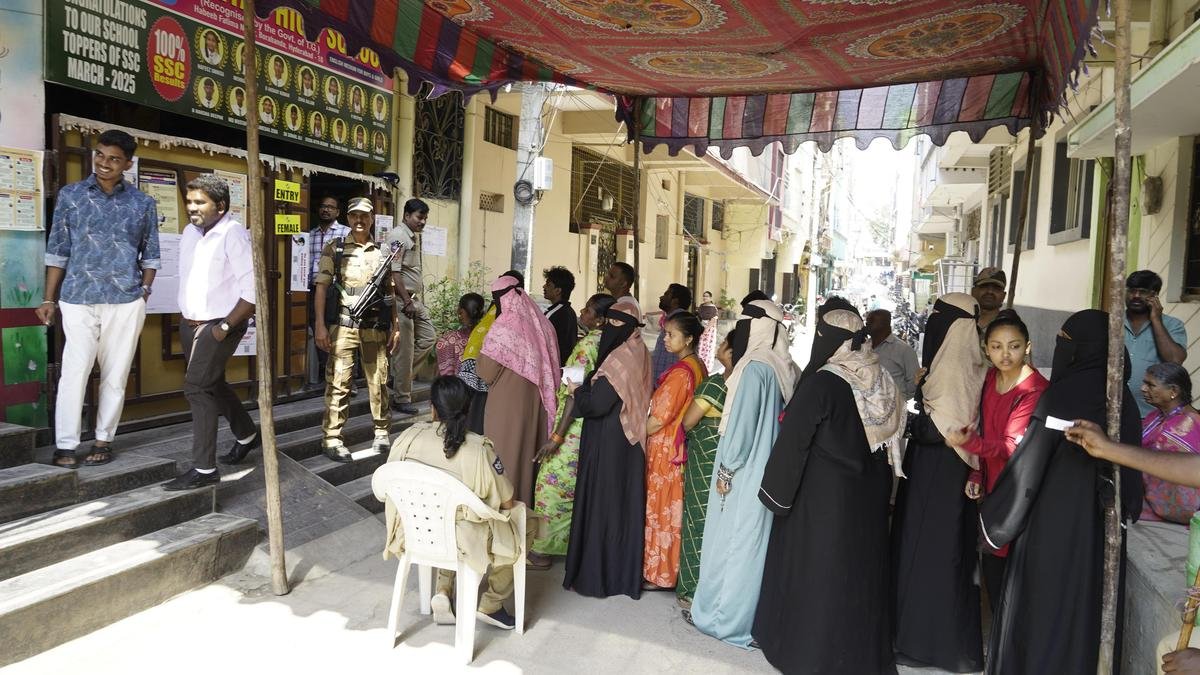The Jubilee Hills Assembly constituency in Hyderabad witnessed a voter turnout of 48.43% in the recent by-election, a slight but significant improvement compared to the 2023 Telangana Assembly elections. The by-poll, held after the demise of former MLA Maganti Gopinath (BRS), was closely watched as a key political test for all major parties — Congress, BRS, and BJP — in one of Hyderabad’s most prominent urban constituencies.
Why the Bypoll Was Significant
The Jubilee Hills constituency represents a diverse mix of high-rise apartments, middle-class neighborhoods, and old city areas. Historically, this urban constituency has recorded low voter participation.
The by-election, therefore, was not only about filling a vacant seat but also about measuring urban voter engagement and testing party strategies ahead of future civic and Assembly elections.
Turnout Overview
The Election Commission reported a 48.43% voter turnout, slightly above the 47% recorded during the 2023 Assembly elections.
Hourly turnout trend:
- 9:00 AM – 9.2%
- 11:00 AM – 20.7%
- 1:00 PM – 31.9%
- 3:00 PM – 40.2%
- 5:00 PM – 47.1%
- Final tally – 48.43%
While still under the halfway mark, the increase reflects a small but encouraging shift in urban voter participation — a space often marked by apathy and low engagement.
Reasons Behind the Turnout Increase
1. Intense Political Campaigning
All three major parties — Congress, BRS, and BJP — conducted aggressive door-to-door campaigns. Street meetings, social media appeals, and local outreach programs helped bring voters to polling booths. Congress, in particular, viewed this bypoll as an opportunity to consolidate its urban voter base.
2. Administrative Preparedness
The Greater Hyderabad Municipal Corporation (GHMC) and election authorities ensured smooth polling by setting up additional booths, improving voter access, and deploying adequate security. The steady rise in turnout through the day reflected better voter management and confidence in the polling process.
3. Local Civic Issues
Civic problems — including poor drainage, road maintenance, and power disruptions — were central to campaigning. Many residents in Borabanda, Yousufguda, and Krishna Nagar expressed dissatisfaction with local governance, motivating a section of voters to participate and push for change.
4. Targeted Voter Awareness
Several local resident welfare associations and youth groups took to social media to encourage participation. This localized awareness drive contributed to the slight rise in turnout, especially among middle-class families.
Persistent Challenges
Urban Voter Apathy
Despite the improvement, the fact remains that less than half the electorate voted. Affluent voters from gated communities and high-rise apartments largely stayed away, highlighting a continued disconnect between citizens and electoral politics.
Uneven Participation
Turnout was higher in middle-income neighborhoods and lower in elite zones. This uneven participation pattern shows that urban electoral engagement is still limited to select segments of the population.
Perception of Irrelevance
Many urban residents perceive by-elections as having little direct impact on governance. This perception, combined with professional commitments and weekend travel, led many voters to skip polling day altogether.
Political Implications
For the Congress
As the ruling party in Telangana, Congress treated this bypoll as a prestige contest. The improved turnout suggests growing voter interest in the party’s performance and its ability to engage urban constituencies, which will be crucial ahead of the GHMC elections.
For the BRS
The Bharat Rashtra Samithi, which held the seat previously, sought to reclaim lost ground. The outcome will determine whether the BRS can remain relevant in urban Hyderabad after losing power in the 2023 Assembly polls.
For the BJP
For the Bharatiya Janata Party, the bypoll provided an opportunity to test its organisational strength in Hyderabad’s urban landscape. The turnout indicates that while BJP’s visibility has increased, translating it into votes remains a challenge.
Why This Turnout Matters
The Jubilee Hills bypoll is more than just a one-seat contest — it reflects the evolving urban political behavior of Hyderabad’s educated, professional class.
Even a 1–2% increase in turnout represents:
- Greater awareness about local governance.
- Improved faith in the electoral process.
- Potential for stronger democratic participation in future elections.
For election officials and political strategists, understanding what worked in Jubilee Hills could shape outreach strategies for upcoming municipal and Assembly contests.
The Road Ahead
1. Strengthening Urban Electoral Engagement
Continuous awareness programs and convenient voting arrangements can help sustain this momentum. Encouraging first-time voters and apartment residents remains key.
2. Leveraging Digital Platforms
Digital reminders, mobile apps, and online engagement can effectively target urban professionals who often miss out due to tight schedules.
3. Addressing Local Issues
Voters repeatedly cite civic infrastructure as their main concern. Governments that deliver tangible improvements between elections are more likely to see higher participation in the future.
4. Building Trust and Accessibility
Transparent governance and responsiveness to citizen grievances will help reduce voter cynicism — the biggest barrier to urban turnout.
Conclusion
The 48.43% voter turnout in the Jubilee Hills bypoll, higher than the 2023 Assembly election, may appear modest but carries deep political meaning. It signals a small yet positive shift in Hyderabad’s urban electoral culture.
While challenges like apathy and unequal participation remain, the improved turnout underscores that with active campaigning, better administration, and citizen awareness, urban democracies can move towards stronger participation.
Do Follow Us Instagram







